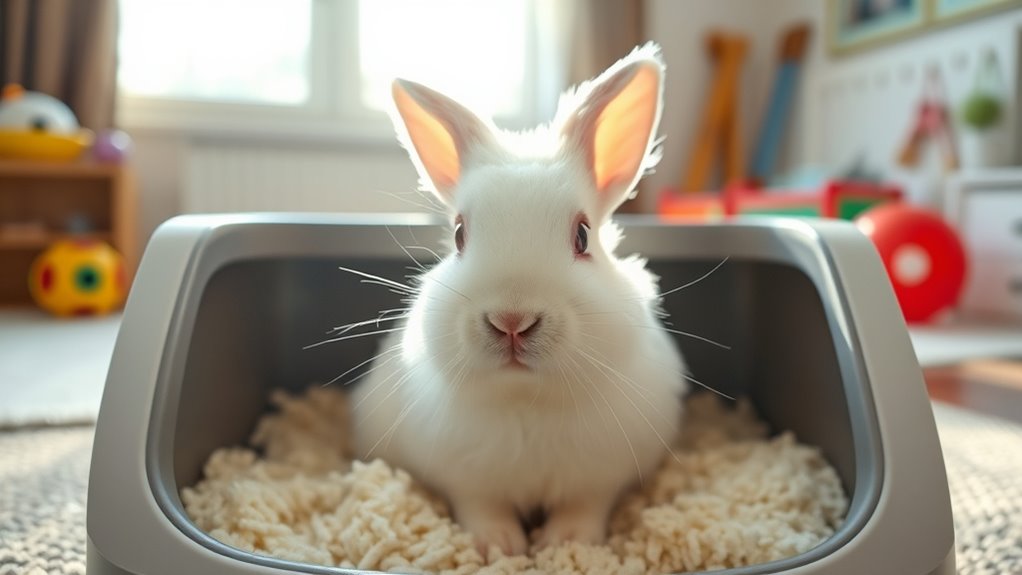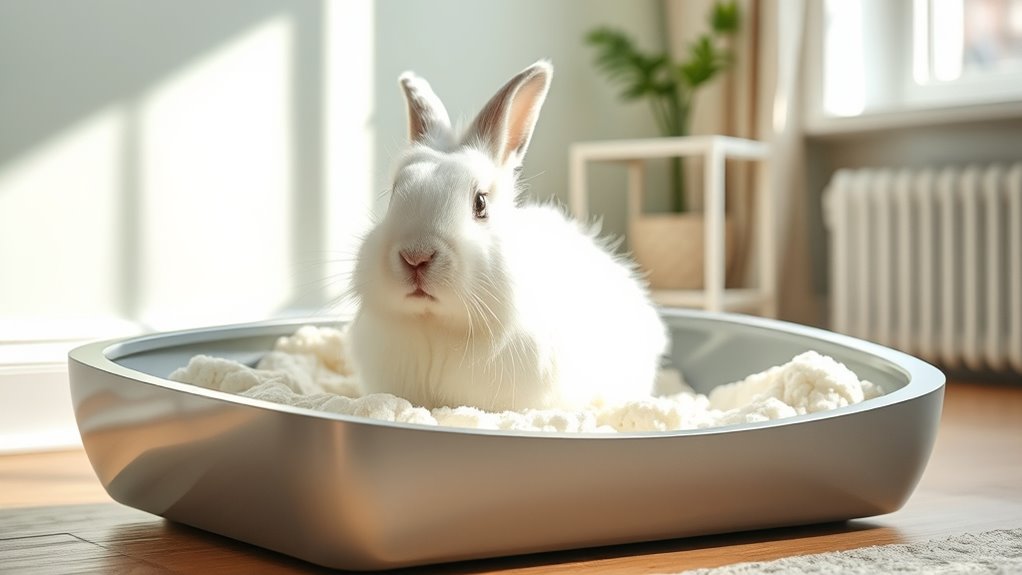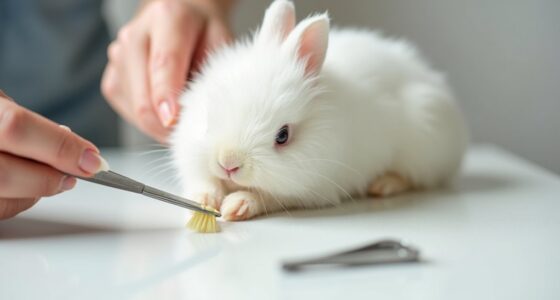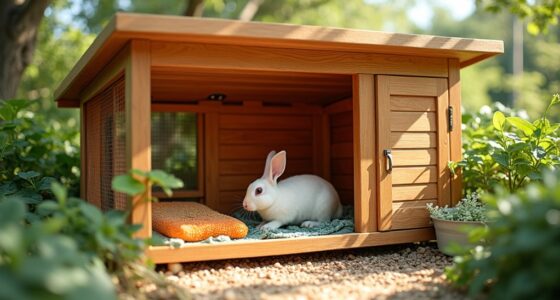You can reach a 99% success rate in litter training your rabbit by applying a proven new method based on positive reinforcement and habitat setup. Focus on using a large, comfortable litter box filled with safe, absorbent materials and place it in a quiet corner. Consistently reward your rabbit for using the box and redirect mistakes calmly. With patience and persistence, you’ll see impressive results—continue to learn more tips to optimize your success.
Key Takeaways
- The new method combines behavior reinforcement and habitat setup for a 99% success rate.
- Using positive reinforcement encourages rabbits to consistently use the litter box.
- Proper habitat setup, including large, comfortable boxes with absorbent substrates, promotes good habits.
- Regular cleaning and redirection reinforce correct bathroom behavior and maintain hygiene.
- Patience and persistence are essential for achieving high success in litter training rabbits.

Litter training your rabbit is an effective way to keep your home clean and make caring for your pet easier. With the new method gaining a 99% success rate, it’s clear that understanding behavior modification and habitat setup plays a pivotal role in the process. When you approach litter training with a focus on behavior modification, you’re fundamentally guiding your rabbit to develop new habits through positive reinforcement and consistency. This involves observing where your rabbit naturally tends to go and then reinforcing that behavior with treats or praise whenever they use the litter box correctly. Instead of punishing mistakes, you redirect your rabbit gently and reward the desired behavior, making the training experience positive and encouraging.
Guide your rabbit with positive reinforcement and patience for effective litter training success.
A key to success lies in setting up an appropriate habitat. Your rabbit’s environment should be thoughtfully arranged to promote good litter habits. Start by choosing a litter box that’s large enough for your rabbit to comfortably turn around in, and fill it with a safe, absorbent substrate like paper-based or wood pellets. Place the litter box in a corner of the enclosure or room where your rabbit spends most of its time—rabbits tend to choose a specific spot, so making that spot convenient and appealing increases the likelihood they’ll use it. Avoid placing the litter box near their food or water bowls, as rabbits prefer separation between their waste and eating areas.
Consistency is essential. As soon as you introduce the litter box, encourage your rabbit to use it by placing some of their droppings or urine-soaked bedding inside. This helps them associate the box with their bathroom needs. Keep the habitat clean by regularly scooping out waste, which not only discourages accidents elsewhere but also makes the litter box more attractive to your rabbit. If your rabbit has an accident outside the box, don’t punish; instead, calmly place them back in the box and reward them for going correctly. Over time, with patience and persistence, your rabbit’s behavior will change, and litter training will become second nature.
The new method emphasizes the importance of understanding your rabbit’s natural tendencies and creating an environment that supports positive habits. By combining effective behavior modification techniques with a well-thought-out habitat setup, you’re providing your rabbit with clear cues and a comfortable space to do their business. This approach minimizes messes, reduces stress, and accelerates the training process. As your rabbit begins to associate the litter box with their bathroom needs, you’ll notice a significant improvement—making both your lives easier and your home cleaner. With dedication and persistence, reaching a 99% success rate in litter training isn’t just a possibility; it’s a reality. Additionally, selecting appropriate educational toys can help teach young rabbits proper habits and routines early on.
Frequently Asked Questions
Can This Method Be Used for Young or Adult Rabbits?
You can use this method for both young and adult rabbits, but consider age considerations and dietary impacts. Young rabbits might need extra patience as they learn, while adults often adapt more quickly. Adjust your training approach based on their age and diet, ensuring they’re comfortable and healthy. With consistency and understanding, your rabbit can successfully be litter trained regardless of age, making your bond stronger and your home cleaner.
What Type of Litter Is Best for Training?
Ever wondered what type of litter makes training easier? When choosing litter, opt for paper-based or aspen wood shavings, as they’re safe and absorbent. Avoid clay or clumping litters, which can harm your rabbit. Consider different litter box options like covered or open trays to see what your bunny prefers. Using the right types of litter guarantees a cleaner, happier space, making training more successful and comfortable for your rabbit.
How Long Does It Typically Take to Train a Rabbit?
Training your rabbit usually takes about 4 to 6 weeks, but it varies based on your rabbit’s behavior and consistency. You’ll need to monitor litter box maintenance closely, reinforcing good habits and cleaning regularly. Patience is key—your rabbit will learn with gentle guidance and positive reinforcement. Keep an eye on their behavior, stay consistent, and soon they’ll be reliably using their litter box, making your bond stronger.
Are There Any Health Risks Associated With Litter Training?
Are you worried about health concerns or injury risks with litter training? You should be aware that, when done properly, litter training is generally safe for your rabbit. Proper litter choice and regular cleaning help prevent health issues like infections or respiratory problems. Avoiding harmful materials minimizes injury risks. Overall, with careful attention, you can successfully litter train your rabbit without significant health concerns or injury risks.
How Do I Handle Accidents During the Training Process?
When accidents happen during litter training, stay calm and avoid scolding your rabbit. Quickly clean the area with accident cleanup supplies to prevent odors. Use reinforcement techniques like praise or treats when your rabbit uses the litter box correctly to encourage good habits. Consistency is key, so handle each accident patiently and focus on redirecting your rabbit to the right spot. This helps strengthen their training and builds a positive routine.
Conclusion
With this new method, you’re on the fast track to success, turning litter training into a walk in the park. You’ll find that patience and consistency pay off, and soon enough, your bunny will be reliably using the litter box. Remember, Rome wasn’t built in a day, so don’t get discouraged if progress takes time. Stick with it, and you’ll see results before you know it—your bunny’s good habits will be second nature in no time.










